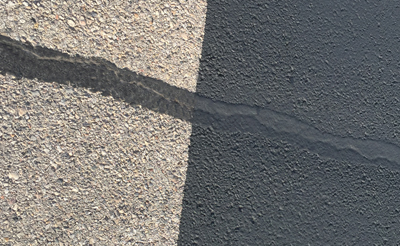
A Must Read for Communities that Hate Crack Sealing Streets
By Mark Beatty / Published June 2022

What makes for an attractive living room? One thing I know for sure is that I’m not qualified to decorate a living room, and I probably wouldn’t even trust myself to pick out a good color for the walls. Most folks are passionate about what they hang in their living room, be it a beautiful piece of artwork, a family picture, or whatever it may be.
Over the years, however, I have experienced something a little confusing and probably a little misguided when it comes to asphalt preservation projects and particularly as it relates to crack seal. What does asphalt preservation have to do with the artwork on your living room wall? Absolutely nothing, but some people try to assess each of them by the same criteria.
Often a pavement maintenance project increases the aesthetic appeal of a community. However, this is only a side benefit. Turning the roads black in a community does not mean that the life of the roads has been effectively extended. The judging criteria for a street preservation project is NOT how beautiful it is—like the painting hung on your living room wall—but whether or not the project is effectively preserving your streets. With some research, communities can successfully achieve both objectives of improving aesthetics and generously extending the life of the pavement. Installing an HA5 High Density Mineral Bond treatment is one of the most successfully used strategies to accomplish both. But even with surface treatments, more than likely, crack seal will be required to some degree prior to a surface treatment being installed.
Guess what? No one likes how crack seal looks, but the community’s decision makers must focus on the purpose and results of installing crack seal, not the look of it. I find that with every article I’m asked to write on the topic of asphalt maintenance I always have to emphasize the need for HOA boards and community managers to become more educated on this topic prior to soliciting bids for a project.
One of the most effective and relatively short (usually 60 to 90 minutes) orientations focused on preserving community streets is available from organizations qualified to teach an approved curriculum from the Florida Department of Professional Regulation. Email mark@holbrookasphalt.com with the subject “Guidance to Lower Street Ownership Costs,” and I’ll direct you to an accredited advisor with an approved curriculum who can provide you with the strategy tips you need.

Left: Crack seal viewed on native asphalt surface without a surface treatment.
Right: Crack seal viewed on asphalt surface with HA5 High Density Mineral Bond installed.
Back to crack seal…Why not just skip it and do a surface treatment only? The goal with an effective pavement preservation strategy is to keep the asphalt pavement flexible. A flexible pavement is more resistant to cracking. The earlier in a pavement’s life that an effective preservation strategy is implemented, the better the asphalt, or bitumen as it’s known, can experience reduced age-hardening that leads to cracking. Crack sealing is necessary to address the damage that has already taken place.
Earlier this week I made my way to the dental chair for my semi-annual teeth cleaning. I’m trying to avoid cavities or serious corrective work like a root canal, etc. If I had a cavity but told the dentist not to address that and to just take care of the cleaning, it would be similar to skipping the crack sealing and only doing the surface treatment to your road. Crack sealing must be done even if it isn’t the prettiest thing to have on your road. Unlike your living room wall, the street in front of your home and throughout your private community is designed for safe and effective transportation. The best ways to avoid needing crack seal is to 1) initiate a preservation strategy with an effective surface treatment in the first few years to reduce the amount of cracking that actually forms and 2) perform crack sealing in conjunction with a surface treatment. That won’t make the crack seal unnoticeable. But depending upon the surface treatment used, if it’s a dark black color, it will likely make the crack seal less pronounced.
Mark Beatty
Senior Vice President, Holbrook Asphalt Company
Mark Beatty is on the Advisory Board for the International Pavement Management Association and consults with public agencies and HOAs throughout the U.S. He is a sought-after presenter at public works events as well as HOA seminars. Mark serves as the Sr. Vice President at Holbrook Asphalt Company. You can contact Mark at mark@holbrookasphalt.com.




